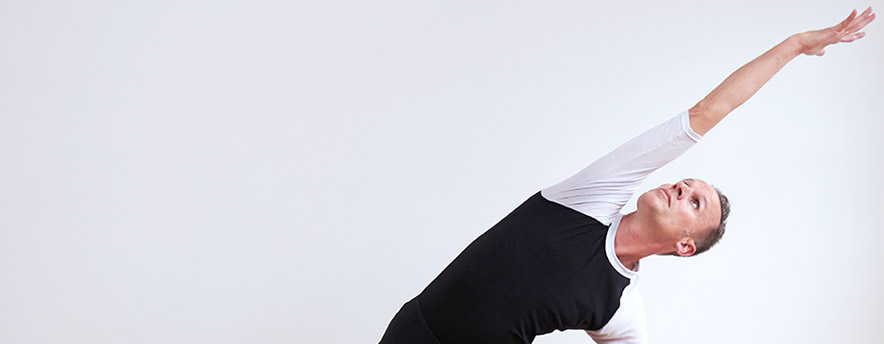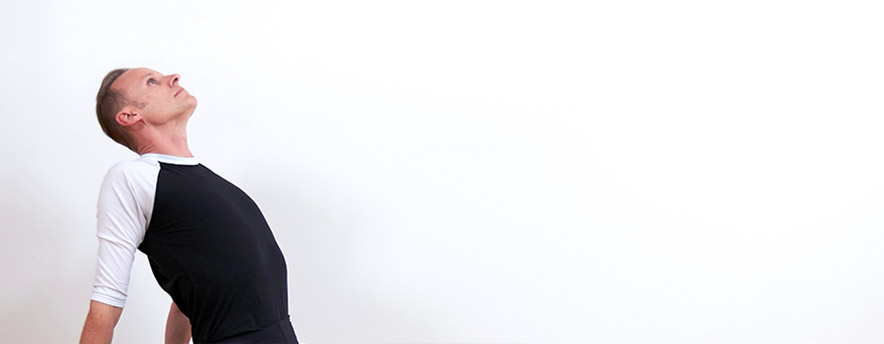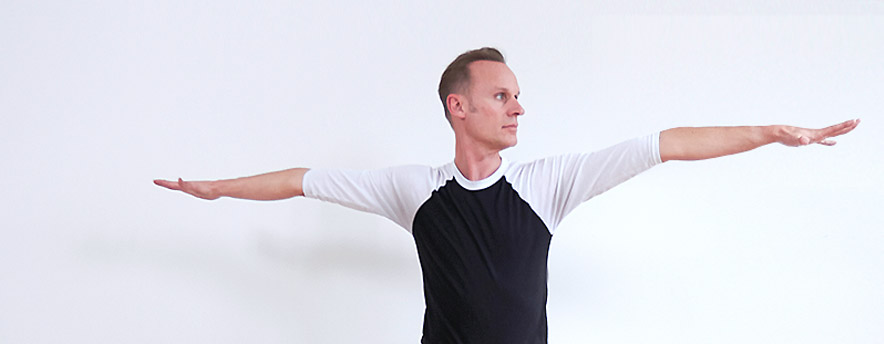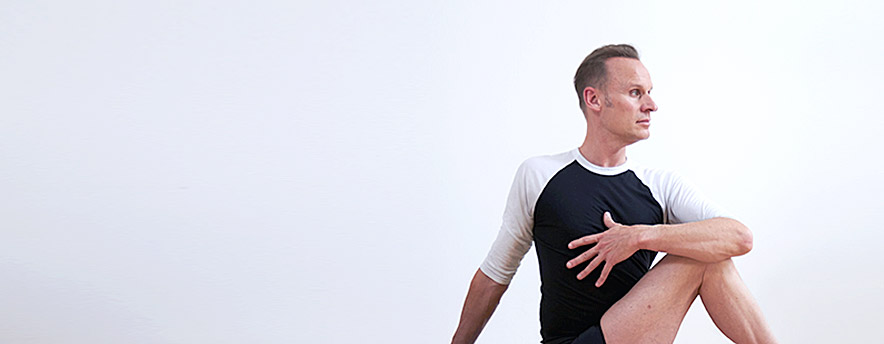About Daniel Clement
Like many yoga practitioners and teachers, I had a natural predisposition to yoga practice. The qualities of self-study, a desire for balance and harmony and a somewhat sensitive and introverted personality served me as a musician and songwriter. I found the same qualities could be directed toward understanding and practicing yoga.
I became interested in hatha yoga in the mid 1990’s as a way to heal a back injury. After attending classes in Iyengar yoga, I gravitated to Ashtanga Vinyasa Yoga and was lucky enough to have Fiona Stang as one of my teachers. I practiced this rather intense form of yoga regularly for 3 years before attending my first teacher training with David Swenson. David honored the yoga his teacher Pattabhi Jois taught him but was not afraid to add his own voice. After that training I was asked to assist with the morning self-led classes at City Yoga in Vancouver. That experience taught me the value of observation; both to the poses the students were working in, and the relationship each student had to the practice as a whole.
I was introduced to Larry Schultz of It’s Yoga in 2001 and after practicing with him, began teaching his variety of “Rocket Yoga” in his Vancouver studio. Larry flew me down to his San Francisco studio where I slept in a loft above the open-air studio, practiced on my own in the morning, studied his teaching style and took his 200 hour training. Larry took the traditional Astanga Vinyasa Yoga sequences and created his own dynamic flows from them. I came back to Vancouver more prepared to teach this demanding practice and less concerned with teaching a traditional style.
I moved to a seaside town called White Rock in 2002, cleared out my living room and began teaching from home. The students there were older than my Vancouver students and deeply uninterested in attempting the acrobatic jump-throughs and arm balances of the yoga I’d been teaching. I had to change what I was teaching in order to serve them.
In the fall of 2003 I was introduced to postural biomechanics by Anusara Yoga teacher Elissa Gumushel, who was kind enough to teach me regularly at her home. By this time I had acquired a deep set of habits in the body through my Astanga Yoga practice, and also many small injuries and misalignments. I realized that though I had developed some strength, discipline and flexibility, I had a superficial relationship with the poses I was doing. I knew the basic forms, but had not spent enough time in each pose in any one practice to really understand how to use the pose to get into the body. I had been using the body to get into the pose. My practice began to change. I also began to question the value of fiercely traditional approaches not only to the physical practice, but also to the more subtle practice of breath, meditation, and philosophy.
In early 2007 I was invited to Shanghai to lead my first 200 hour yoga teacher training. After working from many different books and resources to prepare each day of training in a way that made sense, I promised the students I would write down what I had taught them in a comprehensive way when I got back to Canada. “Teaching Hatha Yoga” was the course manual that evolved from that work.
After leading six to eight 200 and 500 hour trainings per year from 2008 – 2013 in Canada and graduating over 500 teachers, I began to ask some hard questions about what I was doing. Many of the students attending my trainings had little experience with yoga practice. Even the students who had been practicing for years at yoga studios had not developed the home practice essential to effective teaching. Yoga had been offered to them as something that happens in a group, facilitated by and instructor who often had only taken a training course themselves and had not developed a home practice. Like a facsimile of a facsimile, the practice seemed to be degrading. There also seemed to be a desire for quick results rather than dedication to study. The ease of graduating from a 200 hour course was made worse by the new Yoga Alliance mandate that any student attending the hours of a course could register with them as a yoga teacher – whether or not they had illustrated any skill as a teacher.
I created objective certification standards for Open Source 200 hour training in 2014. In order to graduate from Open Source training, the student must demonstrate competency in teaching a 45 minute fundamentals postural sequence.
My work now is to train effective hatha yoga teachers and to explore the more subtle aspects of the healing power of yoga through writing and workshops. Like almost everyone I’ve met who does yoga, I want to share what it has done for me with others. To that end I offer 200 and 300 hour trainings and workshops at my home studio on the gulf island of Texada, British Columbia B.C. in 2017
My family history
I think we gravitate to practices based on some motivation. For me, and perhaps many, my initial motivation to practice postural yoga was back pain. However, further consideration unveiled a deeper motivation. My family, again like many – didn’t always get along well together. My parents, locked in an unhappy marriage without the tools to ameliorate their own suffering, were in some way insufficient examples of happy people. My mother suffers from ADHD and as a relatively logical person, this was difficult for me to internalize and harmonize – I sought peace and quiet, and yoga practice can offer that as a palliative. I think as teachers we have a responsibility to be as transparent with our students as possible in order to avoid projection and potential abuse of influence. When someone knows something about what motivates you, they are more empowered to understand you. If you have questions about my approach to this practice, feel free to ask the hardest questions.
Our Philosophy
O.S. Yoga’s approach is inclusive. As individuals, we learn from one another and have the opportunity to share our innate wisdom in the service of something greater than our individual egoic needs – to expand our consciousness, and to remember our true nature. Yoga is a tool to harmonize all pairs of opposites – to work skillfully with strength and ease, pose and repose, inhale and exhale – to come to the center of our being, to reflect, to remember. This skill simply allows a richer experience of life, intimacy and relationships.
O.S. Yoga encourages inquiry. One meaning of tantra is to weave together – to take apparently disparate threads of knowledge and knit them together into an integrated tapestry. If you look closely at a woven cloth, you can see the individual threads, often different colours and textures. When you stand back, you see the cloth as one. The same is true with schools of yoga. So, rather than a separate system, or school of yoga, which would imply a fixed approach, O.S. yoga is a process – an evolution.
O.S. Yoga views the traditions of yoga, and recognizes that sentience is continually evolving. Sharing wisdom and information freely accelerates evolution. Protecting, branding and copywriting information can serve to clarify, but can also limit the natural expansion of understanding. Both paths exist, and both inform each other by contrast.
O.S. Yoga’s approach to asana is informed by reflection on daily practice, and the understanding that although we may all look similar, we are also all very different – like the individual threads in the cloth. From limb length to bone structure and density, mental and physical dexterity, age, culture and sex, our human experience is unique. The asana practice, to be truly effective, must adapt to the individual.
Practice is not a prescription. We each will approach asana in our own way, given the opportunity. But we can begin with some things we all have in common, as a logical starting point on this path – we can meet at a trail-head and move into the forest on our own path, equipped with the wisdom of those who have gone before.



